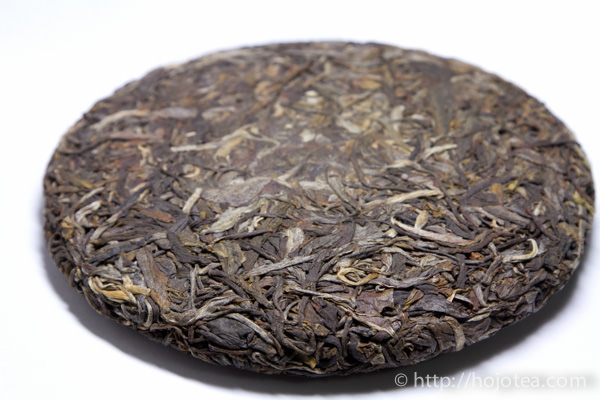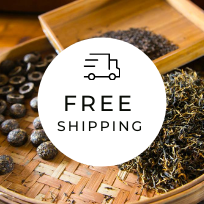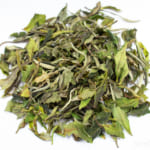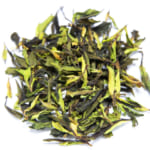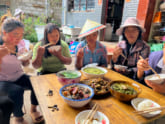- HOME >
- How to enjoy tea
Why is Pu-erh Tea Compressed?
Why is Pu-erh teas compressed? A common answer to that question would be to minimise the volume and for effortless transportation of tea. However, there is another reason that is not widely known.
No oxygen is an ideal environment for maturing Pu-erh tea
I have conducted an experiment of keeping Pu-erh tea for maturation. I analyze the tea condition after keeping the Pu-erh teas in different conditions where some were exposed to ambient atmosphere, some vacuumed, and some using an oxygen absorber to remove 100% of oxygen. As a result, the tea that was kept without oxygen matured in the most ideal way. The Pu-erh tea kept in an exposed condition to the ambient atmosphere absorbs the moisture present in the air; developing some mold on the surface or emitting unpleasant musty odor. On the other hand, the Pu-erh tea that was kept without oxygen developed a sweet flavour that reminds me of honey, and it produced the sweet fruity or sugarcane-like flavour with further storage. Based on these experiments, I have concluded that it is necessary to keep Pu-erh tea without oxygen in order to get it matured very well.
The maturation is different from fermentation
There are some people who insist that the maturation of Pu-erh tea is a process of “fermentation”. However, I absolutely disagree with it because fermentation refers to the chemical reaction that is mediated by enzymes. However, the tea that is vacuum packed contains very low moisture that is insufficient for any enzymatic reaction to occur. However, if tea is kept inside a room with high humidity, it will immediately be contaminated by microorganisms such as mold and bacteria. Furthermore, some inappropriately kept Pu-erh teas would produce musty or earthy flavour if any of them were actually contaminated by the microorganism during storage. Of course, there is a big question mark whether or not it is safe to consume.
The maturation of tea involves no enzyme and no microorganism
Maturation of tea is neither by enzymatic reaction nor microbiological fermentation; but, it involves a non-enzymatic oxidation and reduction process which occurs by altering the constituents in tea leaves. When tea is exposed to the oxygen in the atmosphere, it triggers excessive oxidation. As such, tea will be nothing but oxidized and spoiled. Hence, an ideal environment for having tea matured is without oxygen; yet, one may wonder how would the tea be matured or oxidized when there is no oxygen. In chemistry, there are three definitions for oxidation which are as follow:
- Receive Oxygen
- Release Hydrogen
- Release Electron
As you can see from the above three definitions, we do not really need the oxygen in the air to carry out the maturation (oxidation) process. If you wish to learn more about the definition of the oxidation, please refer to the following page:
http://www.chemguide.co.uk/inorganic/redox/definitions.html
Both compression and suction can remove oxygen
Let’s rewind back to the reason why we need to compress the Pu-erh tea. Usually, if one wishes to completely remove the oxygen that exists in the tea leaves, it is either vacuum it or compress it very hard. Both compression and suction could eliminate the oxygen if the pressure is strong enough. Most of the Pu-erh tea manufacturing places in Yunnan are located deep inside the mountains where it sometimes take more than 20 hours by local bus from Kunming to reach the destination. The idea to compress tea originates from the wise ancient Yunnan folks who wanted to be certain that oxygen was completely eliminated from the tea; moreover, the compressed teas enable a more convenient transportation. Although, the leaves at the surface of the Pu-erh cake will definitely be oxidized; however, the volume of the tea leaves at the external layer of the cake is considered as a very minor amount which is small enough and negligible.
The Pu-erh tea cake used to be compressed very hard
About 20-30 years ago, the Pu-erh tea was often compressed extremely hard that it was known as the “iron bing” (铁饼). It was compressed as hard as a piece of stone that one cannot even break it using a knife or a strong eyeleteer. Based on my experience, all the iron bing Pu-erh tea was ideally matured no matter how it was kept. Thanks to the hard compression, there was no oxygen remaining inside the leaves. These teas produced sweet flavour like dried fruits which I enjoy drinking them so much. Unfortunately, nowadays most of Pu-erh teas are not compressed like an iron bing anymore. If we compress our tea too hard, we would receive a number of complaints from the customer saying that it is really very hard to break apart the tea for drinking. Generally, nowadays most of tea companies compress Pu-erh tea moderately, which will definitely leave some oxygen in the tea leaves. Under the circumstances, tea will get oxidized no matter how it is kept.
Based on the above logic, we pack tea with an oxygen absorber that is made of the reduction iron powder. This will absorb oxygen as iron absorbs the oxygen from the atmosphere to form iron oxide. We are quite satisfied by this method since we can get the tea well-matured in a right environment and at the same time, the Pu-erh tea cake will not be too hard to cause nuisance to the customers.
Related Articles
How to get the latest update on HOJO Tea?
1. Follow Twitter, 2. Click "Like" on Facebook, and 3. Subscribe in newsletter. You can have the latest tea news from HOJO Tea.
 Subscribe the Newsletter to enjoy the privileges
Subscribe the Newsletter to enjoy the privileges- You may receive a free sample upon purchase, or you may have the priority to purchase special products. So please remember to subscribe our newsletter as well as the social network.
- Yunnan Chun Jian Green Tea from High Mountain Gardens
- Yunnan Chun Jian Green Tea is now available.This tea is made from naturally grown leaves harvested from high mountain gardens at 2100m above sea level. It has a rich, long-lasting lingering aftertaste, comparable to raw Pu-erh tea. Yunnan as a Distinctive Tea Growing Region Over the past 20 years, we have explored a wide range …
- Limited Loose Leaf Release of 2025 Da Xue Shan Wild Raw Pu-erh Tea
- We have released the 2025 loose-leaf version of Da Xue Shan Wild Raw Pu-erh Tea.This tea comes from wild tea trees that grow naturally in the high mountains of Yunnan Province, at elevations above 2000 meters. This year, we were only able to secure a small quantity for retail, and the current release is available …
NEW ARTICLES
 Yunnan Chun Jian Green Tea from High Mountain Gardens
Yunnan Chun Jian Green Tea from High Mountain Gardens- Yunnan Chun Jian Green Tea is now available.This tea is made from naturally grown leaves harvested from high mountain gardens at 2100m above sea level. It has a rich, long-lasting lingering aftertaste, comparable to raw Pu-erh tea. Yunnan as a Distinctive Tea Growing Region Over the past 20 years, we have explored a wide range …
 Limited Loose Leaf Release of 2025 Da Xue Shan Wild Raw Pu-erh Tea
Limited Loose Leaf Release of 2025 Da Xue Shan Wild Raw Pu-erh Tea- We have released the 2025 loose-leaf version of Da Xue Shan Wild Raw Pu-erh Tea.This tea comes from wild tea trees that grow naturally in the high mountains of Yunnan Province, at elevations above 2000 meters. This year, we were only able to secure a small quantity for retail, and the current release is available …
 2025 Da Xue Shan Wild White Tea Now Available from Yunnan
2025 Da Xue Shan Wild White Tea Now Available from Yunnan- The 2025 harvest of Da Xue Shan Wild White Tea is now available. Crafted from truly wild Camellia taliensis trees growing naturally in the high-altitude forests of Yunnan, this tea offers a purity and character unique to its origin. This year’s unusually dry climate during the withering season was ideal, resulting in a floral and …
 Why Do Some Teas Taste Astringent? Exploring the Causes and Mechanisms of Astringency
Why Do Some Teas Taste Astringent? Exploring the Causes and Mechanisms of Astringency- Tea can range from having no noticeable astringency to possessing a very strong one. What causes this astringency? This article explores the causes and mechanisms behind astringency in tea. Causes of Astringency Astringency arises from the binding of tea components to proteins in the oral cavity, creating a sensation of tightness or dryness. The tongue …
 The Impact of Heat Sources on Tea Flavor
The Impact of Heat Sources on Tea Flavor- It is widely recognized that the material of a kettle plays an important role in shaping the taste of water for brewing tea. Yet, an often overlooked but equally significant factor is the type of heat source used to boil the water. Different heat sources, whether gas, electric, charcoal, or wood fire, can impart distinct …
 New Release of High Mountain White Tea
New Release of High Mountain White Tea- We are pleased to introduce our High Mountain White Tea, sourced from a unique tea garden with two key features: 1. Located at an altitude of 2200-2300m2. Completely wild and untended The ideal natural conditions of this garden result in tea of exceptional quality, offering a pure and gentle, nourishing taste. High Altitude and Wild …
 New Release of Da Xue Shan Wild White Tea 2024
New Release of Da Xue Shan Wild White Tea 2024- We have released the 2024 Da Xue Shan Wild White Tea Loose Leaf. This tea was produced under our direct supervision during our stay in Yunnan Province, ensuring meticulous production management on site. Definition of Wild Tea in Yunnan Province People in Yunnan strongly associate Camellia taliensis with wild tea, regardless of where it is …
 New Release of Wild Pu-erh Jasmine Pearl
New Release of Wild Pu-erh Jasmine Pearl- Out of curiosity, we decided to create a jasmine tea based on Da Xue Shan Wild Raw Tea. This resulted in an exceptionally rare tea, not only in Japan but also in China. Custom Production Network for Jasmine Tea At our store, we source various types of base teas from different regions during the spring. …
 2024 Overview: Our Yunnan White Tea Quality, Process, and Weather Insights
2024 Overview: Our Yunnan White Tea Quality, Process, and Weather Insights- One of the teas we’ve been focusing on in Yunnan Province is white tea. Historically white tea has been produced in both Fujian Province and Yunnan Province for a long time. While white tea from Fujian Province is well-managed during processing, we are dissatisfied with the quality of the raw materials due to the use …
 Yunnan’s Hospitality Culture: Expressed Through Meals
Yunnan’s Hospitality Culture: Expressed Through Meals- In China, as a form of greeting, it’s common to say “你吃饭了吗?” which means “Have you eaten?” However, in Yunnan Province, the phrase “吃饭” is often used in various situations, more like “Eat, eat,” serving as an invitation to share a meal. Yet, with prolonged exposure to Yunnan, one comes to understand that these meal …
Shop Info

Address:Lot No. T-215, 3rd Floor, The Gardens Mall, Mid Valley City, Lingkaran Syed Putra, 59200 Kuala Lumpur
Tel: +603-2287-4537
Business Hour: 10am to 10pm
Category
- New Arrival at HOJO Online Shop
- Featured Articles
- Newsletter
- Types of Tea
- Origin of Tea
- Teapot and Tea Equipment
- Tea Column
- How to enjoy tea
- Tea Processing
- How to choose quality tea
- Tea constituents and functional effect
- Safety of Tea
- Foods
- Tea Business Operation
- Hobby and Outdoor Activity
- Ranking of Tea
- Video
- FAQ
- Media Release
Profile

- AKIRA HOJO
- I invite you to experience my tea selections.I was born in Nagano, Japan. In university, I studied agricultural chemistry, and I have the master degree in food science. I worked in Japanese food industry for 10 years. I involved in R&D, QC and QA. As a factory manager, I implemented ISO9000 series and managed the factory.
- The Art of Tea Magazine
- We posted the article on “The Art of Tea Magazine No.9, the magazine is published in Taiwan. We featured some scientific view about the tetsubin
- New Straits Times
- The Malaysian National Newspaper, New Straits Times featured HOJO Tea on 17-Oct-2007.


